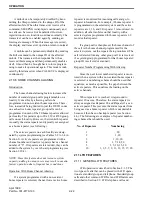
OPERATION
2-11
April 1999
Part No. 001-8170-100
The parameters and the available configurations
for each are as follows:
HIPOWER - High power (Section 2.4.9)
LOPOWER - Low power
KP_LOCK - Keypad disabled (Section 2.4.6)
KP_ENAB - Keypad and key press tones enabled
KP_MUTE - Keypad enabled, key press tones
disabled (Section 2.4.7)
PTT_0TN - Proceed tone disabled
PTT_1TN - Single (soft) proceed tone
PTT_2TN - Dual (loud) proceed tone
56522xx - The “2xx” indicates the version of
operating software in the transceiver.
NOTE: The proceed tone is not available on conven-
tional systems (Section 2.9.4).
For example, to disable the keypad, select the
menu mode and then press the
key to select the
“KP_xxxx” group. Then press the PTT switch to
display “KP_LOCK”. If FCN is then pressed or when
normal operation resumes in 3 seconds, the keypad
will be locked. Turning power off does not change
selected menu mode parameters.
2.7 PHONE MODE
2.7.1 GENERAL
The phone mode is available with telephone
keypad models only. It is selected by pressing the FCN
switch on the side and then the PHON (1) or SND
(SCAN) key as describe in the next section. The phone
mode is enabled when the telephone receiver icon
(
) is displayed (the base
indicates that a tele-
phone group is selected).
The phone mode provides the following features
which make placing telephone calls more convenient:
•
The system/group number or alpha tag in the alpha-
numeric display is cleared so that the dialed tele-
phone number can be displayed.
•
The SYS, GRP, and SCAN keys become, respec-
tively, RCL, CLR, and SND. In addition, FCN STR
changes from quick select switch programming to
telephone number memory store.
•
Numbers can be entered at any convenient rate and
then transmitted automatically when desired by
pressing the SND key.
•
Up to six 14-digit telephone numbers can be stored
in memory and recalled as needed.
•
System and group scan are disabled. Therefore, calls
are received on only the current system and group
(and also any priority or block decode codes if
programmed).
Other phone mode highlights are as follows:
•
Telephone calls can be placed without selecting the
phone mode by simply pressing the push-to-talk
switch and dialing the number. However, the dialed
number does not appear in the display and therefore
cannot be stored or recalled. When calls are
received, selection of the phone mode is optional
because it does not enhance operation.
•
Only the quick select switch can be used to change
the system and group in the phone mode because the
SYS and GRP keys are RCL and CLR keys.
Changing the system/group does not affect the
phone mode which remains selected.
•
Although the phone mode is intended for use in
making LTR-Net and LTR telephone calls, it can
also be used for LTR-Net Unique ID and directed
group calls and in the conventional mode.
•
The main difference in operation in the conventional
mode is when the telephone number can be sent
using the SND key. When a LTR-Net or LTR system
is selected, the dial tone must first be obtained by
briefly pressing the push-to-talk switch. The trans-
ceiver detects the probable presence of this tone by
detecting when receive audio is enabled.
•
When a conventional system is selected, the tele-
phone number can be sent at any time as long as no
carrier is detected. If a carrier is being detected, the
SND key is active only if the monitor mode is
enabled. This ensures that the channel is monitored.
















































